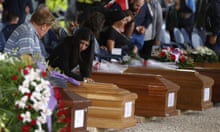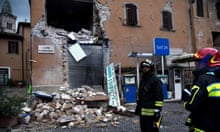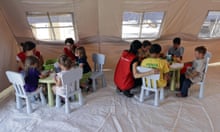Amid the rubble of a town that seems almost to have toppled on to its hillside, it is, miraculously, still standing. But the clock on the 13th-century bell tower in Amatrice is stuck at 3.39 – three minutes after the earthquake struck.
At least 247 people died and dozens more were injured, or feared still trapped in debris, after a powerful pre-dawn earthquake devastated a string of remote hilltop towns and villages across a swath of central Italy on Wednesday.
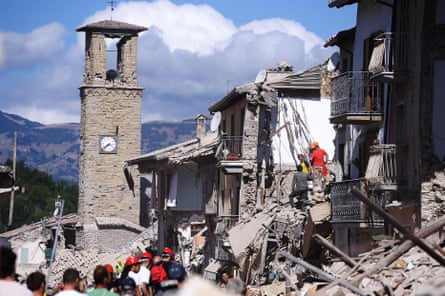
The 6.2-magnitude quake struck at 3.36am when most were still asleep, razing homes, buckling roads and burying residents under mounds of masonry in the hardest-hit towns of Amatrice, Accumoli and Arquata del Tronto.
More than 12 hours after the initial tremor, bulldozers and earthmovers rumbled slowly up winding, deeply fissured roads, while temporary camps and kitchens were being set up to house and feed the several thousand made homeless.
Italy’s civil protection agency wascoordinating the rescue operation after the quake, which was felt in Rome more than 93 miles (150km) away.
Hundreds of rescue crews from around the country, including a six-man team of firefighters from the Vatican, scrambled to the area straddling the regions of Umbria, Marche and Lazio.
“The situation is dramatic, there are many dead. Rescue efforts are under way and it is very, very difficult,” the mayor of Amatrice, Sergio Pirozzi, told reporters. “Much of the village has disappeared. The aim now is to save as many lives as possible.”
The mayor of Accumoli, Stefano Petrucci, was in tears, saying the situation was “even more dreadful than we feared, with buildings collapsed, people trapped under the rubble and no sound of life”.
Two or three nearby hamlets had completely disintegrated, he said, adding that the town’s 700-strong population swells to about 2,000 in the summer and he now feared for its future.
A regional council engineer, Orlando Sandro, said 80% of Amatrice’s old town centre had been destroyed, adding that the foundations of many of the buildings that had not collapsed were so badly weakened they would have to be pulled down.
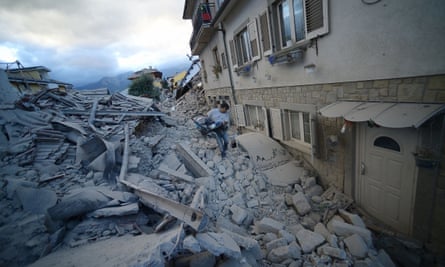
Inside the town, almost every building was cracked and whole streets were filled with rubble. There was an overpowering smell of dust.
A team of a dozen orange-suited emergency workers were busy on a large mound of rubble next to a house sliced almost exactly in half by the tremor, so neatly that a bathtub dangled precariously from an upper storey.
A 10-year-old girl was pulled alive from the rubble in Pescara del Tronto, one of the three towns most severely demolished by the earthquake in central Italy. After nightfall Wednesday, two women ran up the street yelling “She’s alive!”
Chief firefighter Danilo Dionesei confirmed the girl was pulled out alive and was taken to a nearby hospital. He didn’t immediately give any further details about her condition.
Another survivor – a woman wrapped in a foil blanket – was rushed away on a stretcher, followed a few minutes later by a body covered with a blanket.
“What can I say,” said a woman in her 30s, too distraught to give her name, sitting outside a badly damaged house a little further up the street. “This used to be my home. Now I have nothing.”
Luca Faccenda, 65, said he had lost a cousin. The quake was “stronger than any earthquake I’ve ever felt”, he said. His mother’s house, where he spent his childhood holidays, was badly damaged.
“Walking around, seeing everything destroyed like this ... It’s terrible,” he said. “Never in my life, at my age, did I expect to see something like this. It is very hard. Terribly hard. Impossible to comprehend.”

Italy’s prime minister, Matteo Renzi, said the priority over the coming days was to rescue any survivors. Renzi said Italy showed its true face in times of trouble: “No family, no city, no hamlet will be left alone.”
The leaders of both France and Germany, who spent Monday with Renzi at a European Union mini-summit off Naples, offered their condolences and assistance.
President François Hollande said France would provide “all the help that might be necessary” after a “terrible tragedy”, while Chancellor Angela Merkel expressed “the deep sympathy of the German people”.
Pope Francis prayed for the victims and survivors with a crowd of tens of thousands gathered in St Peter’s Square in Rome for his general audience. “Hearing the mayor of Amatrice say the town no longer exists, that there are children among the victims, I am deeply saddened,” he said.
The US Geological Survey measured the quake at 6.2 magnitude and put its epicentre near the Umbrian town of Norcia. Italy’s earthquake institute, INGV, registered it at 6.0 and said the epicentre was closer to Accumoli and Amatrice.
“Most earthquakes come from eight to 10km below the ground,” said a local geologist, Manlio Faraoni. “This one was just 4km deep. That’s why the damage is so severe.”
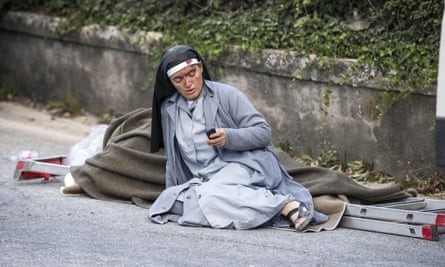
Amatrice is best known in Italy as the birthplace of the bacon-and-tomato pasta sauce that goes into spaghetti all’amatriciana and was full of visitors arriving for its annual festival celebrating the dish, due to have been held this weekend.
The town is made up of nearly 70 hamlets, some of which rescuers had yet to reach. “We’re doing everything we can,” the president of Rieti province, Giuseppe Rinaldi, said, surveying the devastation with a team of engineers and aid workers. “The whole province has been mobilised, everyone who can is here to help.”
One visitor from Rome described the early-morning scene in Illica, a few kilometres north of Accummoli, as “like Dante’s Inferno. People crying for help. Rescue workers arrived after one hour, one and a half hours.”
Later in the day, Guido Bordo, 69, sat wringing his hands in anguish in the same hamlet. “My sister and her husband are under the rubble, we’re waiting for diggers but they can’t get up here,” he told AFP.
“There’s no sound from them, we only heard their cats. I wasn’t here, as soon as the quake happened I rushed here. They managed to pull my sister’s children out, they’re in hospital now.”
As many as 60 aftershocks, some measuring as strong as magnitude 5.5, continued through the day. “The whole ceiling fell but did not hit me,” one shocked resident, Maria Gianni, said. “I just managed to put a pillow over my head and I wasn’t hit, luckily – just slightly injured my leg.”
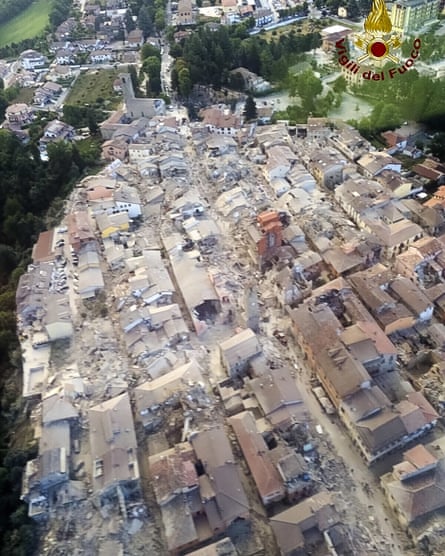
Another hard-hit town was Pescara del Tronto, where the main road was covered in debris and residents were digging their neighbours out by hand as emergency crews had yet to arrive.
Photos taken from the air by regional firefighters showed the town essentially flattened; Italy requested EU satellite images of the whole area to assess the scale of the damage.
Tourists on holiday in the region told the Guardian of their experiences. “The quake and at least one aftershock caused us to run out of the buildings in a panic,” said Nick Mortimer, one of a family of nine gathering for a 60th birthday celebration in nearby Amandola.
Renata Morioni, on holiday a few miles from Amatrice, said: “I felt a very strong shaking at about 3am … It went on for ages – then again about half an hour or 45 minutes later. Terrifying.”
Dr Mark Quigley, an active tectonics and geomorphology professor at the University of Melbourne, said about 13,000 people would have experienced severe ground shaking persisting for probably 10 to 20 seconds, and another 230,000 would have felt very strong tremors.
“This earthquake is no surprise,” said Quigley. “This is one of the most seismically active parts of Italy.” He noted that six severe earthquakes had hit the region in the past seven centuries, including a series of three magnitude-6 quakes in 1703 that killed an estimated 10,000 people. Italy’s deadliest earthquake in the 20th century came in 1908, when a major tremor followed by a tsunami left an estimated 80,000 people dead in the southern regions of Reggio Calabria and Sicily.
As residents, civil protection workers and even priests dug through the rubble, calls went out for more equipment and helpers.
“We need chainsaws, shears to cut iron bars, and jacks to remove beams: everything, we need everything,” Andrea Gentili, a civil protection worker, said. The national blood service appealed for donations to Rieti’s hospital.
“I don’t know what to say. We are living this immense tragedy,” said the Rev Savino D’Amelio, a parish priest. “We are only hoping there will be the least number of victims possible and that we all have the courage to move on.”
Pirozzi, the mayor, said poor access to the village was hampering operations. “There is a landslide on one road, a bridge is about to collapse on the other one,” he said.
The 2009 Aquila quake led to lengthy recriminations over lax building controls and the failure of authorities to warn residents a quake could be imminent. Volunteers from Aquila were among those who made their way to Amatrice on Wednesday to help however they could.
Standing by the roadside just outside the town waiting to be allowed in as survivors filed slowly past, some carrying plastic bags stuffed with belongings, others with their arms in slings, was Ludovica Baschinna, 18.
“I felt it at 3.30, felt the house shaking,” she said. “I was very afraid that it was happening all over again in Aquila. I lived through that earthquake in 2009 and I know what it feels like. So I thought it was just my responsibility today to come here and help out, to lend a hand.”
Stefano Prentera, a doctor, had come from Rome to help, setting up a small makeshift clinic on the edge of town. He said he had been working all day and had treated about 30 patients for minor and more serious injuries. “It’s a very dramatic situation,” he said. “A very difficult time for everyone.”
